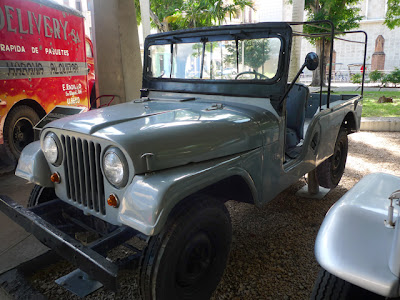 |
| One of two CJ's identified as Juan Almeida Bosque's wartime Jeep. |
Such is apparently possible, however, if it's the 1950s Jeep CJ-6 of Juan Almeida Bosque. Not only is the stout four-wheeler on standing display at the Granma Memorial in Havana – literally, it stands on concrete posts – but it can also be seen in the newly opened Third Front Historical Complex, a Santiago del Cuba museum dedicated to the life and work of Fidel Castro's longtime lieutenant and friend.
To be fair, the Havana Jeep may be described as the "type" or "brand" of vehicle that carried Almeida after its capture from Batista's troops on the eastern front. Its placard isn't clear. And the Jeep in Santiago is identified unequivocally as Almeida's command car in one report, but in another as a "replica."
Hard to tell much about the Almeida museum's Jeep from the photo at the first link, other than it's a CJ-5 or a CJ-6 and would seem to have had a rather sloppy respray. The Jeep in Havana is unmistakably the longer, and far less common, CJ-6. With a wheelbase of 101 inches, the CJ-6 could carry 1,500 pounds or, with its optional side-mounted rear benches, up to eight passengers. Though bought for the Cuban army, this one is a civilian model and not the M38A1 supplied to the American military. Its round rear wheel openings identify it as built in the United States; the CJs that were issuing from the new Jeep factory in Brazil had square openings.
Both the CJ-5 and 6 were introduced in 1955 by Willys Motor Co., a subsidiary of Kaiser, and would stay in production all the way until 1984. They were intended to replace the CJ-3B, but that model, unmistakable for its high hood (necessary to clear the tall F-head engine), also remained in production for years because of demand in export markets. The 3B remains a common sight on Cuban roads.
Juan Almeida Bosque was one of Castro's earliest supporters. A descendant of African slaves, he was the only black leader among the revolutionaries fighting in the Oriente province. He also was a poet, author and composer, and his slow-tempoed bolero love songs can still be heard on Latin radio.
Almeida held top posts in the Castro government, often appearing at the side of Fidel and then Raúl Castro. Good for optics, no doubt, in a nation that has yet to erase its hierarchy of skin tone; but also a measure of respect for a man officially designated a "Hero of the Republic of Cuba."
He died in 2009 at age 82. His coffin, ringed by white flowers, was carried through Santiago streets lined with mourners by a Soviet-built military jeep – not a 1950s Jeep CJ, but fitting nonetheless.
 |
| Almeida, right, in 1959. Photo: www.juventudrebelde.cu |
 |
| He appeared often with the Castro brothers. Photo: www.cadenagramonte.cubaweb.cu |
See also:
CJ-3B outside, Lada inside